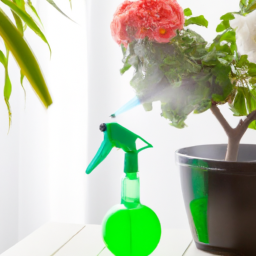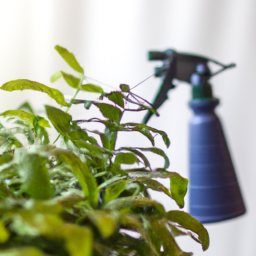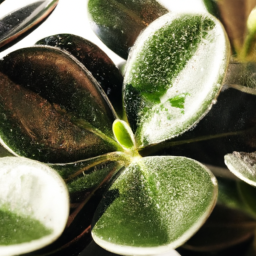
Have you ever wondered how indoor plants clean the air? It’s a fascinating topic that many people are curious about. Whether you’re a plant lover or simply interested in improving the air quality in your home, understanding the science behind this natural air purification process can be enlightening. In this blog post, we’ll explore the ways in which indoor plants effectively clean the air, helping to create a healthier and more vibrant living space. So, let’s dive in and uncover the secrets of how indoor plants work their magic in purifying the air we breathe.
The Science Behind Indoor Plants’ Air Purifying Abilities
Indoor plants not only add beauty and a touch of nature to our living spaces, but they also play a vital role in purifying the air we breathe. Understanding the science behind how indoor plants clean the air can help us make informed decisions about incorporating them into our homes and workplaces. In this article, we will explore the fascinating process by which indoor plants improve air quality and provide a step-by-step guide to creating an indoor garden that promotes cleaner air.
How Indoor Plants Clean the Air
Plants have a remarkable ability to naturally filter and clean the air through a process known as phytoremediation. They do this by absorbing harmful gases and volatile organic compounds (VOCs) from the air and breaking them down into harmless substances. The primary mechanism behind this air purification process is photosynthesis.
During photosynthesis, plants absorb carbon dioxide (CO2) from the air and release oxygen (O2) as a byproduct. This natural exchange of gases helps to replenish the oxygen levels in the surrounding environment. Additionally, plants release water vapor through a process called transpiration, which increases humidity and can help reduce the concentration of airborne pollutants.
Furthermore, certain plants have specific abilities to absorb and neutralize specific pollutants. For example, the peace lily (Spathiphyllum) is known for its ability to remove harmful substances such as formaldehyde, benzene, and trichloroethylene from the air. Spider plants (Chlorophytum comosum) are effective at reducing levels of carbon monoxide and nitrogen dioxide.
Creating an Indoor Air-Purifying Garden
Now that we understand the science behind indoor plants’ air purifying abilities, let’s explore how to create an indoor garden that maximizes their air-cleaning potential:
1. Choose the Right Plants: Select plants that are known for their air-purifying properties. Some popular choices include peace lilies, spider plants, snake plants (Sansevieria), pothos (Epipremnum aureum), and bamboo palm (Chamaedorea seifrizii). Research each plant’s specific air-purifying capabilities to ensure a diverse and effective indoor garden.
2. Consider Placement: Place your indoor plants strategically throughout your living or working space. Aim for at least one plant per 100 square feet of area to optimize air purification. Position plants near windows or other sources of natural light, as they require sunlight for photosynthesis to occur.
3. Provide Adequate Care: Indoor plants require proper care to thrive and effectively clean the air. Follow specific care instructions for each plant, including watering, sunlight exposure, and fertilization. Regularly dust the leaves to prevent dust buildup, which can hinder their air-purifying abilities.
4. Increase Plant Density: To enhance the air-cleaning potential of your indoor garden, consider increasing the number of plants. The more plants you have, the greater the surface area available for gas exchange and pollutant absorption.
5. Monitor Air Quality: Use air quality monitors to assess the effectiveness of your indoor garden. These devices measure pollutant levels, humidity, and temperature, providing valuable insights into the air quality of your living or working environment.
6. Maintain Good Ventilation: While indoor plants contribute to air purification, it’s important to maintain proper ventilation in your space. Opening windows periodically, using fans, or installing air purifiers can help circulate fresh air and further improve indoor air quality.
By following these steps, you can create an indoor garden that not only adds aesthetic appeal but also significantly improves the air you breathe. Indoor plants offer a natural and cost-effective solution to combat indoor air pollution, making them an essential addition to any home or workplace.

Best Indoor Plants for Air Purification and How They Work
Indoor plants not only add beauty and tranquility to our living spaces but also play a crucial role in purifying the air we breathe. They act as natural air filters, removing harmful toxins and releasing fresh oxygen into the environment. In this article, we will explore the best indoor plants for air purification and delve into how they work their magic.
1. Snake Plant (Sansevieria trifasciata)
The Snake Plant, also known as Mother-in-Law’s Tongue, is a popular choice for indoor air purification. It is highly efficient in removing toxins like formaldehyde, benzene, xylene, and trichloroethylene from the air. This plant has long, upright leaves with a striking pattern, making it an aesthetically pleasing addition to any room.
Snake plants work by absorbing toxins through their leaves and converting them into harmless substances. They also release oxygen during the day and night, making them ideal for bedrooms where fresh air is essential for a good night’s sleep. Place them near windows or in well-lit areas, as they thrive in bright indirect light.
To care for a Snake Plant, ensure it is potted in well-draining soil and water it sparingly, allowing the soil to dry out between waterings. Avoid overwatering, as it can lead to root rot.
2. Peace Lily (Spathiphyllum)
The Peace Lily is not just a beautiful flowering plant; it is also an excellent air purifier. It effectively removes toxins like formaldehyde, benzene, trichloroethylene, and ammonia from the air. The Peace Lily’s elegant white flowers and glossy green leaves make it a popular choice for both homes and offices.
This plant works by absorbing harmful chemicals through its leaves and roots, breaking them down into nutrients for its own growth. It also increases humidity, making it beneficial for dry indoor environments. Place Peace Lilies in areas with indirect sunlight and water them regularly, keeping the soil moist but not soggy.
It’s important to note that Peace Lilies are toxic to pets, so if you have furry friends, make sure to keep them out of reach.
3. Boston Fern (Nephrolepis exaltata)
The Boston Fern is a classic choice for indoor air purification. It effectively removes toxins like formaldehyde, benzene, and xylene, making it a valuable addition to any space. Its lush, feathery fronds create a soothing and refreshing atmosphere.
Boston Ferns work by absorbing pollutants through their leaves and roots, trapping them within their intricate network of tiny hairs. They also release moisture into the air, increasing humidity and reducing the risk of respiratory problems. These plants thrive in bright, indirect light and prefer slightly moist soil.
To keep your Boston Fern healthy, mist its leaves regularly to maintain humidity levels and water it when the top inch of soil feels dry. Avoid placing it near drafts or heating vents, as it prefers a more stable temperature.
By incorporating these air-purifying plants into your indoor spaces, you can enjoy cleaner and fresher air. Remember to choose plants that suit your lifestyle and space requirements, and don’t be afraid to experiment with different varieties. With proper care and attention, these plants will not only enhance your surroundings but also contribute to a healthier living environment.

How Do Indoor Plants Clean the Air?
Indoor plants not only add a touch of natural beauty to our living spaces but also play a crucial role in improving indoor air quality. They act as natural air purifiers by filtering out harmful pollutants and releasing oxygen, creating a healthier and more pleasant environment for us to live in. Understanding how indoor plants clean the air can help us make informed choices when it comes to selecting and caring for our green companions. Let’s explore the key mechanisms through which indoor plants improve indoor air quality.
1. Absorption of Pollutants
One way indoor plants clean the air is by absorbing pollutants through their leaves and roots. The leaves of plants have tiny openings called stomata, which allow them to take in carbon dioxide for photosynthesis. These stomata also serve as entry points for gaseous pollutants like formaldehyde, benzene, and xylene, commonly found in indoor environments. Once inside the plant, these pollutants are broken down and transformed into harmless byproducts through a process known as phytoremediation. This natural purification mechanism helps to reduce the concentration of harmful chemicals in the air.
Moreover, the roots of indoor plants also play a vital role in air purification. They have the ability to absorb volatile organic compounds (VOCs) present in the soil. VOCs can be released by common household items such as cleaning products, paints, and furniture. By taking up these compounds, indoor plants prevent them from evaporating into the air and becoming potential respiratory irritants.
It is important to note that different plants have varying capacities to absorb pollutants. Some plants, like the Peace Lily and Spider Plant, are particularly effective at removing formaldehyde, while others, such as the Boston Fern and English Ivy, excel at reducing benzene levels. By selecting a variety of plants with complementary pollutant-absorbing capabilities, you can create a more comprehensive air purification system in your indoor space.
2. Increased Humidity
Indoor air can often become dry, especially during the winter months when heating systems are in use. Dry air can lead to various health issues like dry skin, irritated nasal passages, and respiratory discomfort. Indoor plants can help combat this problem by releasing moisture through a process called transpiration. Transpiration is the evaporation of water from the leaves of plants. As plants release moisture into the air, they increase humidity levels, creating a more comfortable and healthier environment.
Moreover, higher humidity levels can also help reduce the survival and transmission of airborne viruses and bacteria. Dry air tends to make respiratory droplets smaller and lighter, allowing them to remain suspended in the air for longer periods. On the other hand, when humidity levels are optimal, respiratory droplets tend to be larger and heavier, causing them to drop to the ground more quickly. This can help minimize the spread of respiratory infections, especially during flu seasons or in crowded indoor settings.
However, it is important to strike a balance with humidity levels. Excessive moisture can create a breeding ground for mold and mildew, which can negatively impact indoor air quality. Therefore, it is essential to monitor humidity levels and ensure proper ventilation to prevent any potential issues.
3. Enhanced Air Circulation
Indoor plants not only passively clean the air through absorption and humidity regulation but also contribute to improved air circulation. The movement of air around plants, known as natural convection, helps disperse airborne particles and prevents stagnant air pockets from forming. This is particularly beneficial in enclosed spaces where air circulation may be limited.
Furthermore, plants can act as natural air filters by trapping dust and other airborne particles on their leaves and stems. As air passes through the plant, these particles get caught in the plant’s surfaces, effectively removing them from the air. Regularly dusting the leaves of your indoor plants can help maintain their air-filtering efficiency.
Additionally, the presence of indoor plants can also help reduce the concentration of carbon dioxide in the air. Through the process of photosynthesis, plants absorb carbon dioxide and release oxygen, which can help maintain optimal oxygen levels indoors. This can be especially beneficial in spaces with limited ventilation or in areas with high levels of indoor air pollution.
By understanding these mechanisms, you can make informed decisions when selecting indoor plants for air purification purposes. Remember to consider the specific pollutant-absorbing capabilities of different plants, monitor humidity levels, and ensure proper air circulation to maximize the benefits of indoor plants in improving indoor air quality.
Essential Points
Indoor plants not only add a touch of greenery to our homes and offices but also play a crucial role in purifying the air we breathe. You might be wondering, how exactly do these lovely plants clean the air? Well, let’s dive into it.
Plants have a remarkable ability to absorb harmful gases and pollutants while releasing oxygen through a process called photosynthesis. They act as natural air filters, removing toxins such as formaldehyde, benzene, and xylene that are commonly found in indoor environments. These pollutants can originate from various sources like cleaning products, furniture, and even the air we bring in from outside. By having indoor plants, we create a healthier and fresher atmosphere as they actively work to eliminate these harmful substances. Additionally, plants also increase humidity levels in the air, which can be beneficial in dry indoor environments and help alleviate respiratory issues. So, not only do indoor plants enhance the aesthetics of our spaces, but they also contribute to our overall well-being by keeping the air clean and purified.
Frequently Asked Questions from our readers:
Q1: How do indoor plants clean the air?
A1: Indoor plants clean the air through a process called phytoremediation. They absorb harmful pollutants from the air and convert them into oxygen through photosynthesis. The plants’ leaves, roots, and soil all play a role in removing toxins and improving air quality.
Q2: What kind of pollutants can indoor plants remove?
A2: Indoor plants can effectively remove various pollutants commonly found in indoor environments. These include volatile organic compounds (VOCs) emitted by household products, formaldehyde from furniture and carpets, benzene from plastics, trichloroethylene from solvents, and even airborne mold spores. They act as natural air purifiers, reducing the levels of these harmful substances.
Q3: How many indoor plants do I need to clean the air in my home?
A3: The number of indoor plants you need depends on factors such as the size of your space and the specific plants you choose. As a general guideline, it’s recommended to have at least one indoor plant per 100 square feet of living space. However, if you want to maximize air purification, you can have more plants distributed throughout different areas of your home.
Q4: Do all indoor plants have the same air-cleaning abilities?
A4: No, not all indoor plants have the same air-cleaning abilities. Some plants are more efficient at removing certain pollutants than others. For example, the snake plant (Sansevieria) is known for its ability to filter out formaldehyde, while the peace lily (Spathiphyllum) is effective in reducing levels of benzene and trichloroethylene. It’s important to choose plants that target the specific pollutants you want to address.
Q5: Can indoor plants improve air quality for people with allergies or asthma?
A5: Yes, indoor plants can help improve air quality for individuals with allergies or asthma. They can reduce the presence of allergens and irritants in the air, such as dust, pollen, and mold spores. However, it’s crucial to note that some people with severe allergies or sensitivities may be allergic to certain plants or their pollen. It’s best to choose plants that are less likely to trigger allergies and to monitor your own reactions when introducing new plants into your home.
Dr. Olivia Green is a botanist with over two decades of experience in indoor plant cultivation. She holds a Ph.D. in Plant Biology and has dedicated her career to researching plant behavior in controlled environments. Dr. Green is passionate about helping plant enthusiasts master the art of indoor gardening through her extensive knowledge and practical insights.


